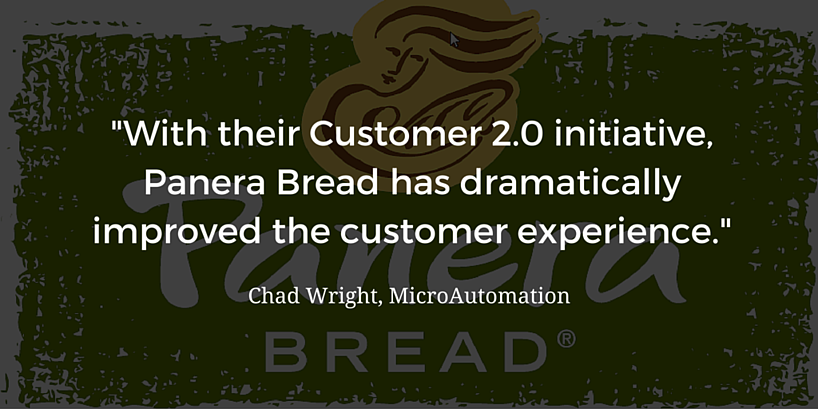Feb 28 2017 Need A Lesson In Reducing Customer Effort? Look No Further Than Panera Bread

Before I try to convince you to look at Panera Bread as a shining example of how to make the lives of your customers easier, let’s address the elephant in the room. I am not a bread bowl-wielding stock owner trying to subliminally push you toward enjoying all of your meals at Panera Bread. Nor is Panera Bread a customer of MicroAutomation.
It is, however, one of my favorite restaurants. And not just because their food is oh, so delicious. With their Customer 2.0 initiative, Panera Bread has dramatically improved the customer experience. So now they’re serving their paninis with a side of “enhanced guest experience.”
I bring this up because I like to recognize companies where implemented changes focus on the principles of reducing customer effort. Books published by Forrester and CEB on the present research also support the strategy of improving service by reducing the amount of effort your customers have to go through in order to do business with your company.
What Do Customers Really Want?
Conventional wisdom leads us to believe that if we delight our customers, or provide them moments of wow, it will improve customer satisfaction and that will drive a loyal customer for life.
Makes sense, right? Well, the truth is not so neat and tidy.
In the real world, brand loyalty is cultivated when you reduce your customers’ efforts by addressing their three core wants:
- “Value my time.”
- “Engage me.”
- “Know me.”
These guiding principles shouldn’t be a huge shock to your system. When we’re off the clock, we’re all consumers who don’t want our time wasted, seek to be engaged in a way that’s efficient and desire some level of personalized attention that demonstrates we’re special.
And the fact that Panera’s Customer 2.0 initiative addresses all three of those needs is why they’re winning at the reduced customer effort game.
“Value My Time” with Simplification
Panera’s Customer 2.0 initiative simplified the guest experience by implementing table service for customers. Back in the old days, it used to be that you ordered and paid for a meal, stood in a crowd of people and waited for a pager to vibrate indicating that your food was ready for pick-up. And the dreaded lunch rush period, you basically had to swim through an unending sea of shoulder-to-shoulder people to get to the counter. But your work wasn’t done yet. Then, you had to determine which of the four to six food trays actually contained your order.
Overall, it wasn’t a great experience for customers who were basically shouldering the majority of the effort of getting their food.
Now it’s a different story.
During a recent lunch with my wife, we ordered our food and sat down in a booth and enjoyed a five-minute conversation before our meal arrived. No longer was I relegated to the role of the vigilant, battle-ready husband waiting in a crowd for food, while the wife finds a table. Instead, we were able to spend more time enjoying each other’s company.
With their new table service, they’re demonstrating they value my time by simplifying the effort involved with eating at a Panera restaurant.
“Engage Me” with Guidance
A second benefit of the Customer 2.0 initiative are the multiple improvements Panera made to guide customers to the most efficient way to interact with the company.
Looking back in time again, it used to be that you would have only one or two registers open to take customer orders. And that’s it. So during lunch I often ended up waiting 10 minutes or more to place an order. That’s a one-way ticket to eroding customer loyalty, because in those long lines, I would start to think, “Why didn’t I just pack a lunch?” or, “Maybe I should abandon ship now and grab a salad somewhere else.”
Today, you have the option to use a self-service kiosk to place an order in addition to the traditional register and the wait time was eliminated. They also have a mobile app where customers can pre-order their meal, ahead of their arrival.
Again, the restaurant is driving my loyalty by valuing my time and guiding me to the best way for me to engage with them. Of course, Panera “noobies” might have questions and will want to speak to someone about the menu. But as a seasoned Panera regular, I always order the same thing.
Show You “Know Me” with Personalization
Finally, I want to talk about the My Panera rewards program. When I place my order at one of their kiosks or through the Web app, I am given the option to enter my phone number and select the past orders option. I find my regular lunch pick two combo and re-order it again.
This a great example how they use customer data in a smart way to demonstrate Panera knows me, and then I’m rewarded with a personalized experience that also doesn’t waste my time. I don’t have to read through numerous pages of their menu or look at options I don’t want. They are driving loyalty by personalizing the experience with my past buying choices.
Final Thought
One of the reasons I’m putting a spotlight on Panera Bread’s Customer 2.0 project today is because it’s something you can experience for yourself first-hand, as a model to follow to improve customer loyalty. Reduced customer effort drives repeat business and increases revenue per customer, in addition to making your customers happy.
And ultimately, isn’t that what we all want to achieve?
